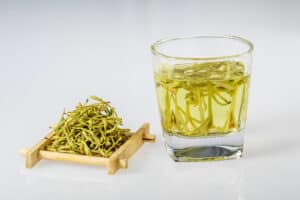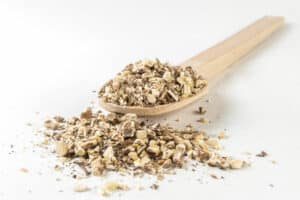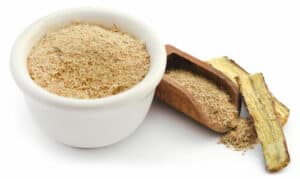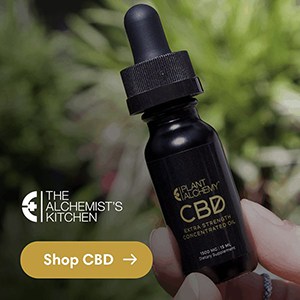As the equinox approaches, our bodies awaken in tandem with the earth, bringing forth the reception for spring cleaning. During this period, we free ourselves from the heaviness and lethargy of the cold season with the offering of liver cleansing tonic herbs. The liver is our main elimination channel. It neutralizes toxins and detoxifies pathogens. It is responsible for over 2,000 chemical functions in the body and takes the brunt of human choices every day. In so many words, the liver is one of, if not, the most important organ in our body!
In tandem with my March 1st class, this article will focus on why it is important to nourish the liver not only in spring but also on a daily basis, while also diving into which herbs speak directly to liver healing functions. As a clinical herbalist and natural health practitioner, I particularly specialize in gut and liver health, so please join our free class and reach out with questions throughout the community workshop. In fact, after healing my own chronic illnesses, I found that by healing my liver, I truly healed my whole body.
What the Liver Does
The liver is one of the most multi-functional, hard-working organs in the body, silently performing a multitude of responsibilities on a daily basis. Our tireless defender can be summed up as a three-pound sponge that soaks up, breaks down, and releases waste and toxic materials.
The liver works incredibly hard every day to purify and filter out harmful substances, neutralize poisons, regulate the metabolism, balance carbohydrates, proteins, and fats, synthesize important molecules and support the immune system. In fact, the liver is so important, that it has its own immune system that performs six immune functions: hepatic vessel white cells, hepatic portal vein white blood cells, hepatic artery white blood cells, lobule white immune cells, bile duct white blood cells, and liver lymphocytes.
However, we start seeing chronic illness and sluggish liver symptoms when the liver is overburdened by modern stressors, pollutants, and negative lifestyle choices. Liver issues can come from, to name a few: petro and household chemicals, plastics, radiation, smoke, stress, pathogen overload (i.e. viruses, bacteria, fungi, parasites), toxic heavy metals, pharmaceutical medication, and a diet loaded with inflammatory foods such as eggs, dairy, pork, and gluten. However, by adding herbs alongside holistic lifestyle changes, most everyone can benefit from supporting their liver’s metabolic functions on a daily basis.
Herbal Actions
A herbal action is a term used extensively in an herbalist’s jargon. It refers to a specific effect a plant has on the human body. These actions speak directly to liver health, referring to the botanicals and the work they do in the body.
- Tonic – strengthens specific organ or whole body
- Anti-inflammatory – helps combat inflammation
- Cholagogue – stimulates bile release
- Demulcent – soothes and shields irritated internal tissue
- Depurative – cleanses waste toxins from body
- Hepatoprotective – provides protection for liver
- Alterative – restores health and vitality; blood cleanser
- Choleretic – increases volume of secretion of bile from liver
- Hepatic – aids, tones and strengthens the liver
Herbs
Herbs contain a complex blend of phytocompounds that differ from each other. Liver herbs in particular contain various bitter alkaloids and secondary metabolites that help protect, decongest, detoxify and re-ground the digestive system as a whole.
Artichoke
Botanical Name: Cynara scolymus
Parts Used: Leaves, flowers
Herbal Actions: Antioxidant, antiemetic, cholagogue, choleretic, depurative, diuretic, hepatic, hepatoprotective
Key Constituents: organic acids – cynarin, caffeoylquinic, chlorogenic; bitter lactones, flavonoids, inulin, luteolin, n-butanol
Helps With: Supports detoxification, protection and metabolic functions of gallbladder and liver, helps with digestive irregularities, supports healthy production and release of bile, improves sluggish digestion and poor absorption
Element: Earth
Magical Uses: Aphrodisiac spells and potions
Ethnobotanical History: Ancient Romans used it for culinary and medicinal purposes. They specifically valued it to increase bile production and urine. As the Greek myth goes, the first artichoke was a beautiful woman named Cynara, who lived on the island of Zinari. Zeus fell in love with her and decided to make her a goddess. However, Cynara missed her home and would sneak back to visit earth from Mount Olympus, thus angering Zeus, who returned her back to earth and transformed her into the first artichoke.
Honeysuckle
Botanical Name: Lonicera caprifolium
Parts Used: Flowers, seeds, leaves
Herbal Actions: Astringent, depurative, diuretic, expectorant, anti-bacterial, anti-viral
Key Constituents: Inositol, luteolin, tannins, volatile oils, and salicylic acid
Helps With: Cooling inflamed conditions by clearing heat and removing toxicity from the body
Element: Earth
Magical Uses: Inducing dreams of passion, helping those who suffer from nostalgic dwelling, attract money, heighten psychic powers and protection from feveres
Ethnobotanical History: Native Americans traditionally made infusions of leaves to heal wounds, as well as, as a natural remedy for rheumatoid arthritis, mumps, hepatitis and upper respiratory tract infections.

Yellow Dock
Botanical Name: Rumex crispus
Parts Used: Roots, seeds, leaves
Herbal Actions: Alterative, purgative, cholagogue, astringent, bitter, laxative
Key Constituents: Anthraquinone glycosides, tannins
Helps With: Cleans up rogue liver toxins, clears bile passageways, improves bile production, purges sediment from the gallbladder, squeezes out old blood to draw in fresh, new blood through the hepatic portal vein and hepatic artery, skin complaints
Element: Air
Magical Uses: Sprinkle an infusion of yellow dock around a place of business to attract customers.
Ethnobotanical History: The Iroquois made root decoctions to treat stomach, kidney and bowel problems, as well as a blood purifier and antidote for poisons. Blackfoot, Paiute, and Shoshone tribes used the root topically by mashing it on to sores and swellings. The Aztecs called yellow dock “atlinan”, meaning “its mother is water” and “axixpatlicóztic”, meaning “yellow urine medicine,” using it as a diuretic and remedy for menstrual pain and heavy bleeding. In addition, ancient Greeks used the leaves as a blood purgative and to treat sores, eyes, itchy skin and glandular swelling.
Schisandra
Botanical Name: Schisandra chinensis
Parts Used: Fruit (berries)
Herbal Actions: anti-depressant, adaptogen, antioxidant, astringent, antitussive, anti-cholesterol, hepatoprotective, oxytocic, Tonic,
Key Constituents: Acids; lignans – deoxyschizandrin, gomisins, pregomisin, schizandrin; phytosterols – beta-sitosterol, stigmasterol; volatile oils
Helps With: Protects liver cells from excess adrenaline damage and toxin overload, increases oxygen to the liver, calms liver spasms and reduces toxic liver heat, increases the nervous reflex response, promotes vitality and longevity, strengthens immune system
TCM Nature: Warm
TCM Tastes: Sour, Sweet
Meridian Affinity: Heart, Kidney, Lungs
Ethnobotanical History: Used in traditional Russian medicine for respiratory ailments, insomnia, kidney problems and diarrhea. Hunters and athletes would use it to combat fatigue and increase endurance. Use in TCM dates back as far as 2697 BCE, where it was and still is known as “the five flower fruit” that would “calm the heart and quiet the spirit.” It was documented in early Chinese medical texts as a superior herb, promoting wellbeing, longevity, and vitality, with medicinal use for coughing, insomnia, night sweats, and physical exhaustion.
Milk Thistle
Botanical Name: Silybum marianum
Parts Used: Seeds
Herbal Actions: Cholagogic, choleretic, tonic, galactagogue, hepatoprotective, alterative, antioxidant, antifibrotic
Key Constituents: Flavones – silybin, silydianin, silychristin; flavonoids; essential oils
Helps With: Stimulates liver function, detoxes toxins, gunk, and debris in hepatic veins, improves bile production, cleanses bile pathways, rejuvenates and removes stagnation from liver, stimulates the digestion, fights free radicals, improves gallbladder and kidney health
Element: Fire
Magical Uses: Used in spells for strength, protection, healing, exorcism, and hex breaking
Ethnobotanical History: History of use dates back over 2000 years ago, where Dioscorides used the seeds as a serpent bite and infant remedy in 40 AD. Basques were said to have used a seed decoction for digestion, bleeding, and regulation of blood pressure, while in traditional German medicine, it was used as a soothing agent. In traditional Lebanese medicine, the seeds were used for gallstones, liver problems, and stimulating milk production and in traditional Turkish medicine, a decoction of milled and roasted seeds was used for bronchial diseases. Various traditional North African cultures have been found to have used seed tinctures for respiratory illnesses and varicose veins.
Dandelion
Botanical Name: Taraxacum officinale
Parts Used: Root, leaves
Herbal Actions: Diuretic, alterative, tonic, decongestant, bitter, cholagogue, anti-rheumatic, laxative
Key Constituents: Glycosides, triterpenoids, choline
Helps With: Resets filtering liver capabilities, expels toxins and purges liver, supports liver’s adaptation strength, converts nutrients, increases bile strength, soothes liver heat and anger
Element: Air
Magical Uses: Use in dream pillows, sachets or teas for sleep protection. Also used for in divination spells and for calling spirits.
Ethnobotanical History: Known as a humble cure-all, dandelion roots and leaves were used in North American, European, and Chinese traditional medicines for centuries. Native Americans would use make infusions and decoctions to treat kidney disease, and liver, skin, and stomach. In TCM, dandelion was used to treat stomach and breast milk problems and appendicitis. In other European cultures, the plant was used in remedies for boils, diabetes, diarrhea, eye problems, and fever.

Chicory
Botanical Name: Cichorium intybus
Parts Used: Root
Herbal Actions: Tonic, laxative, diuretic, anti-inflammatory, hepatic
Key Constituents: Inulin, sesquiterpene lactones, mannitol, latex, lactucin, lactucopicrin
Helps With: Reduces gallstone production, gentle detoxification, almost all digestive issues, feeds the intestinal flora, tones and detoxifies liver
Element: Air
Magical Uses: Removing obstacles, invisibility, favors, frugality
Ethnobotanical History: Throughout the Renaissance period, chicory’s milky sap was used to regulate milk flow in nursing mothers, and the flowers were used to treat inflamed eyes. The bruised leaves were used in poultices for swelling, while root extracts were used as diuretics, laxatives, and to treat fevers and jaundice.
Burdock
Botanical Name: Arctium lappa
Parts Used: Root
Herbal Actions: Alterative, cholagogue, hepatic, hepatoprotective, diuretic, antibacterial, anti-inflammatory, anti-tumor, anti-fungal, antimutagenic, antipyretic, diaphoretic, hypoglycemic
Key Constituents: Flavonoid glycosides, bitter glycosides, alkaloid, antimicrobial, inulin
Helps With: Improves liver functions, regulates glucose, vitamin, and mineral storage, filters blood, purges liver of deep toxins, decongests digestion and liver, improves bile production, improves skin conditions
Element: Water
Magical Uses: Used for cleansing when feeling highly negative about oneself or others. Use in protection incenses and spells.
Ethnobotanical History: Burdock was a prominent medicine in traditional European and North American armamentaria. During the Middle Ages, the root was used as diuretic to purify the blood, especially to rid the body of syphilis. North American tribes would use the whole plant as a food source. Delaware peoples would use the roots to treat rheumatism, Cherokee and Iroquois peoples would use it to purify blood and aid circulation, and Cowlitz peoples would drink decoctions for whooping cough. Additionally, burdock can be found in TCM for treating colds, flu, and other throat and chest conditions.
Chaga
Botanical Name: Inonotus obliquus
Parts Used: fruiting body fungus
Herbal Actions: adaptogen, anti-cancer, viral, bacterial, microbial, inflammatory and protozoa, immuno-modulating, stimulating and protective
Key Constituents: Betulinic acid, melanin, polysaccharides/beta-glucans, B vitamins, inotodiol, lanosterol
Helps With: Strengthens the liver, reduces toxic liver heat, steady detoxification, enhances response to infection, suppresses inflammation, reduces oxidative stress, works as a longevity tonic, restores endocrine and adrenal function, promotes immune support, regulates body’s intake of sugar, lowering inflammation, fighting cancer
Element: Earth
Magical Uses: Alchemizing, regenerating, death, renewal, healing, empowering, creativity
Ethnobotanical History: Known by the Siberians as “the gift from god”, chaga has been traditionally used for centuries by native people from the Scandanavian, Siberian, and Russian territories to support vibrant health. From the Khanty people of Western Siberia to the Ainu people of Hokkaido, Sakhalin and Kuru islands, chaga was beloved as a true king of kings. Interestingly, chaga comes from a word used frequently in an indigenous Russian language, чага, meaning mushroom. The Sami of Fenno-Scandinavia called chaga báhkkečátná to declare it as one of the most important gifts from nature. Chaga didn’t even first appear in western texts until the 16th century. According to ethnobotanical history, chaga was traditionally used to boost immune system health, especially for nomadic tribes and during the frigid winter months. chaga was known to strengthen the body and prevent disease of any sort. The Khanty people would especially use chaga to rid the liver of infection and get rid of parasitic worms. The Ainu people would perform religious ceremonies by smoking chaga out of pipes crafted by the tribe and would be slow-boiled as a tonic by healers to lower inflammation.
Licorice
Botanical Name: Glycyrrhiza glabra
Parts Used: Root
Herbal Actions: Expectorant, demulcent, anti-inflammatory, anti-viral, antispasmodic, laxative, hepatoprotective, adaptogen, antidepressant
Key Constituents: Glycosides – glycyrrhizin, glycyrrhizinic acid; saponins; flavonoids; volatile oil; coumarins; asparagine; oestrogenic substances
Helps With: Expels viruses and other pathogens from liver, lowers liver heat, calms internal spasms, increases hydrochloric acid, soothes gallbladder and intestinal lining, helps with adrenal depletion, ulcer removal, heartburn, acid reflux, and bronchial issues
Element: Water
Magical Uses: Carry to attract a lover, or chew to attract lust and love. Used in spells for fidelity and brewed into a tea for voice restoration. Licorice sticks make useful wands as well.
Ethnobotanical History: The root was used throughout ancient medicine, including in such traditional cultures as with the Babylonians, the Brahmans, the Chinese, the Greeks, the Hindus, and the Romans. The Hindu people would use licorice to increase sexual vigor in a beverage with milk and sugar. During the Middle Ages, Licorice was used to alleviate mild or severe food poisoning from spiced and overcooked food, fat, and often-contaminated meats.

Bupleurum
Botanical Name: Bupleurum falcatum
Parts Used: Roots
Herbal Actions: Adaptogen, antifibrotic, anti-inflammatory, cytoprotective, hepatic, hepatoprotective, immunomodulating, immunostimulating
Key Constituents: Coumarins; flavonoids – rutin; polyacetylenes; polyhydroxy sterols; polysaccharides – bupleurans; trihydroxy fatty acids; triterpenoid saponins – saikosaponins, saikosides
Helps With: Synthesize liver enzymes, and blood lipids, regulate metabolic, hepatic and digestive functions, improves general liver function and detoxification, reduce inflammation and repair damaged liver cells, inhibit growth of liver cancer cells
TCM Nature: Cool
TCM Taste: Bitter
Meridian Affinity: Gallbladder, Liver
Ethnobotanical History: Known as “Xia Yao San” or “Xia Yao Wan,” it was used in Traditional Chinese Medicine (TCM) to disperse Qi and clear heat from the liver network. It supported liver functions and detoxification, and was never consumed solo for its ability to release toxins from the liver, but not eliminate it from the body alone. It was also used in traditional Japanese Kampo medicine to address liver concerns.
Hibiscus
Botanical Name: Hibiscus sabdariffa
Parts Used: Flowers/calyces
Herbal Actions: cardioprotective, immunostimulating, diaphoretic, circulatory, anti-inflammatory hepatoprotective, antidepressant, anxiolytic, emmenagogue, astringent
Key Constituents: Chlorogenic acid, cryptochlorogenic acid, glycoside, gossypetin, hibiscetine, kaempferol, neochlorogenic acid, sabdaretine, anthocyanin
Helps With: Rejuvenates liver, cleaning mucus off cell membrane walls, improving liver function, gallbladder rejuvenation, mitochondrial function, energy homeostasis, cardiovascular health, inflammation, endothelial dysfunction, oxidation
Element: Water
Magical Uses: Attracts love and lust, divination, and dreams. Carry in a sachet or burn as incense to attract love. You can also drink hibiscus tea as part of your love ritual.
Ethnobotanical History: In traditional Caribbean medicine, hibiscus was, and still is, used as a cooling tea for summer heat, especially in Trinidad and Tobago. Ethnobotanical sources have found that the leaves were used for their countless medicinal properties in numerous countries in northern Africa. In addition, in India, the flower was traditionally used as an offering to goddesses and used for a myriad of medicinal actions as well.
Oregon Grape
Botanical Name: Mahonia repens
Parts Used: Root
Herbal Actions: Anaphrodisiac, antimicrobial, antiseptic, antitumor, bitter, blood purifier, cholagogue, depurative, diuretic, expectorant, hepatoprotective
Key Constituents: Alkaloids – berberine, berbamine, canadine, hydrastine; phytochemicals – jatrorrhizine, hydrastine, columbamine, tetrahydroberberine, tannins oxyacanthine
Helps With: Stimulate liver function, improve the flow of bile, blood cleansing, relieve liver congestion, acid reflux, ingestion, eczema, dermatitis, and psoriasis, combat skin irritations, helps kill viruses and bacterial, reduces pathogenic activity, allows for better absorption
Element: Water
Magical Uses: Money and prosperity charms
Ethnobotanical History: Once known as “Indian barberry,” Oregon grape root was used by Native American tribes for dysentery, fungal infections, gastrointestinal aid, kidney support, skin problems, and as a general health tonic. The Apache peoples used the root as a gum remedy, while the Nitinaht, Sanspoil, and Miwok peoples used it for respiratory ailments. In addition, the Blackfoot communities used it as a blood purifier and remedy for infants. The fruit itself was used for culinary purposes, while the bark, leaves, and stem, were crafted into fabric dyes
Balmony
Botanical Name: Chelone glabra
Parts Used: Dried aerial parts
Herbal Actions: gentle cholagogue, antiemetic, stimulant, laxative, anti-bilious
Key Constituents: Bitter iridoids, resin
Helps With: liver tonic, liver protection, stimulate secretion of digestive juices, heal dyspepsia, debility and jaundice, liver disease, worms in children, relieve skin and gallbladder inflammation, digestion upset, and anorexia
Magical Uses: Steadfastness, patience, and perseverance
Ethnobotanical History: Native Americans brought attention to this herb, through its utilization for blood purification, eczema, inflammatory conditions, and liver and gallbladder problems, as well as, for its gentle healing for children.
Fringe Tree
Botanical Name: Chionanthus virginicus
Parts Used: Bark, root bark
Herbal Actions: Hepatic, cholagogue, alterative, diuretic, tonic, antiemetic, laxative
Key Constituents: saponin – chionanthin; glycoside (phyllirine)
Helps With: Liver and gallbladder tonic stimulates bile flower, heals jaundice, strengthens function of pancreas and spleen, stimulates appetite and digestion, wound healing
Element: Water
Magical Uses: Divine protection, harmony and ease, prosperity
Ethnobotanical History: Fringe tree was introduced to European settlers by Native Americans to treat various conditions such as canker sores, and overall inflammation of the body. The Choctaw tribe applied the mashed bark to cuts, bruises, and infected sores, while many other southern and southeastern tribes used the root bark for fevers and liver disorders, and as poultices on sores and wounds.
How to Take Liver Herbs
Some of the quintessential methods to take liver-supportive herbs is through the use of vinegar bitters, infusions or decoction teas, supplement or powder extract, alcohol-free tinctures, and syrups. It is important to note that I believe in using alcohol-free tinctures for such conditions, as alcohol is counterproductive in the cleansing process. As well, vinegar bitters are a fantastic way to incorporate gentle liver support into your diet. They support a natural detox while encouraging the healthy production and release of bile.
If you are looking to make your own herbal liver blends, a great reference is one of my product creations, Happy Liver tea, or my Liver Detox Tea recipe article.







